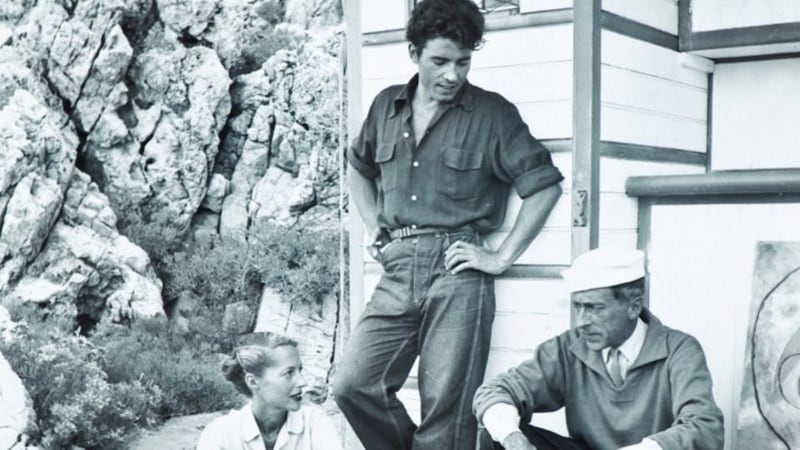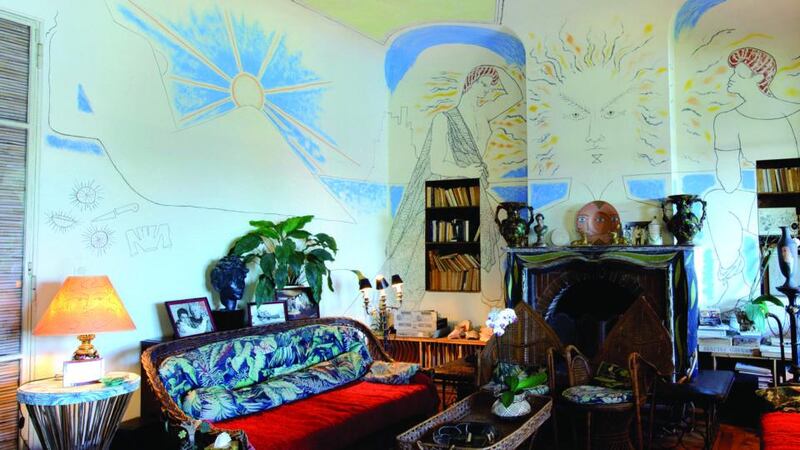The Villa Santo Sospir faces the lighthouse off Cap-Ferrat, the bay of Villefranche, and Nice in the distance. For more than a decade, Francine Weisweiller, a rich and beautiful Jewish socialite who had escaped the Holocaust, lived there in a ménage-à-trois with the gay painter, poet and film-maker Jean Cocteau and Cocteau’s bisexual lover, Édouard Dermit.
In August 1943, one of Francine’s lovers, an Italian diplomat, warned her that the Germans were about to extend their occupation of France all the way to the Mediterranean. Francine, her husband Alec and their infant daughter Carole fled to a farm near Pau. Alec’s mother, who refused to leave her home in Antibes, perished at Auschwitz.
One day, during a raid by the Gestapo, Alec and Francine hid for hours in a ravine, covered with leaves. If they survived, Alec promised, he would buy Francine the house of her dreams.


When the war ended, the Weisweillers regained their mansion on the Place des États-Unis in Paris, and their fortune. Alec purchased the Villa Santo Sospir, with its spectacular sea views, for Francine. It was named after the rocky point where, in centuries past, the wives of fishermen sighed and waited for the return of their husbands.
After her marriage to Weisweiller, Francine had affairs with Prince Aly Khan, who left her for Rita Hayworth, and with her husband’s cousin, Guy de Rothschild. The actress Simone Simon became Alec’s semi-official mistress. The Weisweillers remained on friendly terms and never divorced.
Nicole de Rothschild, another cousin of Alec, introduced Francine to Cocteau in 1949, when he was filming Les Enfant Terribles. Cocteau established deep friendships with three successive female patrons: Viscountess Marie-Laure de Noailles and Coco Chanel before the war; Francine Weisweiller after.
Chanel was treated as a pariah after the war, because she’d had an affair with a German officer. She closed her boutiques and could no longer subsidise Cocteau’s creations. So Weisweiller took her place.
Cocteau was exhausted on completing Les Enfants Terribles. Francine invited him and his new conquest, the handsome son of a Yugoslav coal miner, to spend a week at Santo Sospir. Édouard quickly seduced Francine. He and Cocteau stayed for nearly 12 years.
Cocteau had spotted Édouard Dermit in the gardens of the Palais Royal when he went to cry on the shoulder of his friend Colette, over the loss of his great love, Jean Marais, to another man.
Édouard was known to all as “Doudou” and Cocteau was his Pygmalion. “Cocteau taught him exquisite manners. He was very gentle,” recalls Michel Déon (94), the French academician who lives in Co Galway. As a friend of Cocteau, Déon was a frequent visitor to Santo Sospir.
Édouard and Francine’s affair took place literally under the eyes of Cocteau. “Cocteau liked to sit in that armchair, smoking his opium pipe, while they made love,” says Éric Marteau, who was Francine’s nurse and confidant for the last 11 years of her life, and is now the guide to Santo Sospir.
It may not have been the first time that Cocteau made love by proxy. In the 1930s, he wanted to marry Princess Nathalie Paley, the daughter of a Russian grand duke. Paley had an affair with Cocteau’s then lover, Marais.
Cocteau and Francine loved each other platonically, and his passion for Édouard was rooted in contemplation of Édouard's beauty. Carole Weisweiller, Francine's daughter, writes in Je l'appelais Monsieur Cocteau: "When the poet met Francine in 1949, he had just turned 60. Age and a long addiction to opium had markedly reduced his sex drive."
Cocteau fantasised about founding a family, Marteau says. From 1950 until 1962, Cocteau and Francine played the roles of Monsieur and Madame. When Cocteau joined the Académie francaise in 1955, Francine accompanied him to the quai de Conti in her Bentley, threw a reception in his honour in her mansion. Cocteau legally adopted Édouard, and treated Carole Weisweiller and Édouard’s little sister Émilienne as his daughters.
“Everything changed when Monsieur Cocteau and Doudou came into my mother’s life,” Carole wrote, ever the poor little rich girl. “I discovered the family life I had only dreamed of.”
Cocteau, Francine and Édouard were inseparable. They painted together in the atelier Francine built in the garden. When they travelled to Venice, Florence and Marbella, Francine took her own hotel room while Cocteau and Édouard shared another. During the winter months in Paris, Cocteau and Édouard stayed in Cocteau’s tiny flat, but dined at the Weisweiller mansion.
“Nobody was sleeping with anybody,” Carole insists. Nonsense, says Marteau: “They never tried to hide it.” It was common knowledge that Francine was with Édouard, Déon confirms.
Cocteau designed the Cartier ring with three colours of gold as a symbol of their threesome. Three lines, or three circles, appear often in the frescoes which Cocteau “tattooed” – his choice of verb – throughout Francine’s villa. He started with Apollo, above the fireplace. Quoting Matisse, Cocteau continued: “When you decorate one wall, you decorate them all.” He added the fishermen of Villefranche with their nets, sea urchins, the local fougasse bread, then peopled the villa with a host of nymphs, fauns, unicorns, Greek gods and Biblical characters.
Squeamish as Carole is about sex at Santo Sospir, she freely admits to the drug use. “My mother always took drugs,” she says. Cocteau wrote a book about his own opium addiction. Through Cocteau, Francine too became addicted. Sweet, gentle Édouard procured opium for them in nightclubs.
“Opium came from French Indochina, and it was quite freely available until the communists took over,” Déon explains. “They were discreet about it, but you could smell it in the house.” When Déon made a negative comment about drug addicts at lunch one day, “The table went silent. It cast a chill over my friendship with Cocteau.”
The coast was a haven for artists and intellectuals, many of them homosexuals. US navy ships docked at Villefranche. “The sailors walked around, tall and handsome. They were invited into every home,” Déon recalls. “The local gays were delighted.”
Picasso lived an hour to the west, at Vallauris. “He was the centre, the magnet who attracted everyone,” Déon adds. “Cocteau admired him a great deal, and at the same time he was terribly jealous. Picasso was disdainful of Jean’s painting; Jean wanted to be Picasso’s equal.”
Picasso and his wife Jacqueline visited Santo Sospir, and attended bullfights with Cocteau and Francine. Marlene Dietrich and Greta Garbo came to dinner. The conductor Herbert von Karajan met his wife Eliette, a model for Dior, on the Orpheus II, Francine's black-hulled yacht with a white sail painted by Cocteau. Francine was dressed by the great couturiers – Chanel, Dior, Saint-Laurent, Givenchy, and Balenciaga. They too visited the villa.
Marteau dates the golden age of the Côte d’Azur from the arrival of Ernest Hemingway in 1930 until Mick Jagger’s marriage in Saint Tropez in 1967. “After that, it became bling-bling; nouveau riche,” he laments. You used to see Picasso, Cocteau, von Karajan in the streets of Saint-Jean. Now people stay home behind high walls with bodyguards. Everything has been bought by Russians, and they are very cold people.”
Francine Weisweiller became a recluse in old age. She died a decade ago, in the bedroom that Cocteau decorated with frescoes of the huntress Diane, at the age of 86. “She remained a seductress to the end,” Marteau smiles. “When anyone entered the room, she flashed those blue eyes and let the strap of her nightgown fall from her shoulder.”
A photograph in Carole’s book shows Francine and Cocteau at the bullfight with the Picassos. Francine told Marteau she was so thrilled when the bull was killed, on the day the photograph was taken, that she threw her jewels into the arena. “The toreador brought the jewels to her room that night. They danced the tango and made love,” he recounts.
The tale of the rich woman and the toreador appeared in Blood and Sand, a 1941 film starring Tyrone Power and Rita Hayworth. After Aly Khan left her for Hayworth, Francine banned her household from seeing Hayworth's movies. Yet, supreme irony, she appears to have appropriated the scene acted by her rival.
In 1962, Francine fell in love with a young writer. Their romance did not last, but it ended her idyll with Cocteau and Édouard, whom she expelled from Santo Sospir. Cocteau was deeply wounded. Carole sided with him against her mother. “I suddenly realised how much suffering lurks behind the appearance of happiness,” she wrote. “Everything I believed to be permanent crumbled around me.”
In October of the following year, Édouard summoned Francine to Cocteau’s bedside. There were no witnesses to their last meeting, but Francine insisted they made a full reconciliation. Cocteau died within hours. Because he died on the same day as Édith Piaf, his passing was little noticed.
Cocteau's 1952 colour film, La Villa Santo Sospir, can be seen on YouTube.
Guided visits to the Villa can be arranged by email at santosospir@aliceadsl.fr, or by telephone on (33 4) 93 76 00 16.













